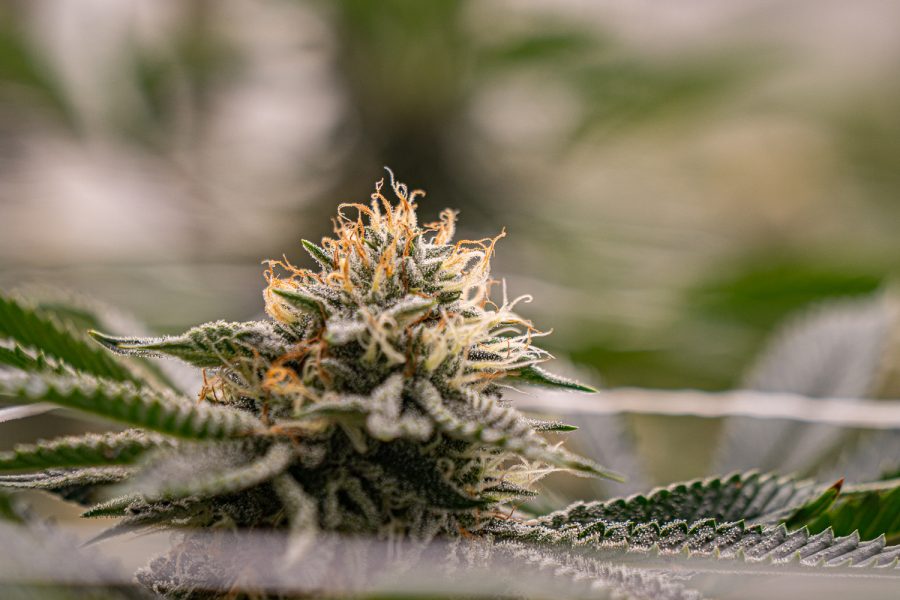Seed to sale: The cycle of cannabis to the consumer
Collegian | Tri Duong
Cannabis growth of Wedding Cake, an indica strain at the Organic Alternatives growth facility Feb. 3. The flowering stage is reached after staying vegetative for 3-16 weeks.
February 9, 2023
When entering a dispensary, it can feel undefined as you’re presented with lists of different products that get you elevated above the Rockies. But what you might not know is the many steps it takes to get your flower ready to be smoked.
Like any other plant, a cannabis plant needs lots of tenderness and guidance in order to provide a suitable product to harvest.
In a facility located in Fort Collins, the work to bring consistently enjoyed flower to the community is done in a passionate and precise way. Jeremiah Lucas, director of cultivation for Organic Alternatives, a dispensary on the northeastern side of Old Town, took us through the process of how they grow and harvest all of their flower.
To start establishing a cannabis plant, you can go one of two ways. You can either plant a seed, or you can take a branch off an already healthy plant and input that branch into a small pot. At Organic Alternatives, they only take branches off other plants in a process called cloning.
“So this is our clone room here,” Lucas said. “We don’t do anything from seeds (because) a seed can be a male or female plant. We grow only female plants here.”
Male cannabis plants produce pollen sacks, while female plants create buds, and those buds hold the most THC, the end goal for cannabis growers.
The rooted branch starts with being covered by a lid 24 hours a day to increase the humidity along with being fed root hormones and water to strengthen the plant as it sits in a little tray among its peers. A few days later, the lids come off, and the plants are exposed to more light and air while getting used to being outside of their very humid environment.
After about two weeks, the cloned plants are ready to be transferred to soil and an individual pot for another two weeks. They are moved to a different room, where the plants start to fill in their new home with sturdy roots.
Once those clones look like they’ve adjusted well to their new environment, they are relocated to a 3-gallon pot, where they’ll continue to grow for about three weeks. In this time, the plants can be a few feet tall, allowing them to be pruned to provide more clones.
“We’ll take another set of clones if we need to clone it, we’ll shape the plant, we’ll prune them, we’ll basically just give it more time to establish into these pots and then we’ll send them into the flower room,” Lucas said.
After about two months, the once-small branches are now a few feet tall and are almost ready to be introduced to the flower rooms.
“Cannabis switches into flowering on a photoperiod, meaning if you (give) it 11 hours or more of darkness, the plant will start flowering, so as long as you keep that plant with more light than darkness, it’ll stay in this vegetative state so you can keep pumping out clones,” Lucas said.
To clarify, if you keep the plant exposed to more light, it will stay in a stage where it will continue to grow but not sprout buds, allowing you to take clones more often. If you start secluding the plant in darkness, it will then adapt to that environment and start producing sites for the buds.
The plants will stay in this environment for a few weeks as they prepare to be moved to the final stages before being harvested. Once the plants have been through several weeks of adjusting to more time in the light, they are sent to the long-awaited flower rooms.
This is the longest part of the cycle as the plants will spend up to nine weeks going through light phases, growing closer to 5 feet tall and birthing buds.
“We’re just about three weeks (into this stage) in this room,” Lucas said. “(The) plants are much taller, they have more light, so they’re going to stretch. (There is) more carbon dioxide in here. We change the watering strategy, and the plants just respond to the change in environment.”
Once the large canopies of plants start to produce buds, the growers look at the color changes of the pistils and trichomes to gauge the stage of the plant. The pistils are those stringy tentacle-type strands around the bud, and trichomes are the leaves around those buds and pistils that are a dark green and look like they have sugar sprinkled all over them. The growers look for both of these parts of the plant to turn from white or milky colored to a darker orange and amber tone.
Fast forward to about two months later, and the plants have grown large chunks of flower waiting to be collected. The growers clip off a foot or so at a time of stems with buds that are then transferred to rows of poles to hang.
The once-bright green lanky plants now dangle in a much colder and drier environment for as long as they need to turn into a sellable product.
“From this point, we’ve cut off all the extra stems and just kept the flower, and we’re trying to reduce the amount of moisture within the flower,” Lucas said. “(Once) it dries down to the right moisture and density, then we start breaking down the flower off of the stems and then continue that process as we trim off the smaller leaves (to then) dry it, cure it (and) maintain its freshness.”
A sample of the flower is then sent to a testing facility where a few days later, they will get the THC potency and terpenes percentages, which then allow the workers to separate the strain for flower and pre-roll packaging that will be sent to the local store.
The entire cycle from a cloned branch to smokable flower takes eight to nine months, but with a perpetual agenda of 58 strains and 6,000 plants on site, Organic Alternatives always has something fresh and ready in their store.
With strain names like Devil Driver, Blue Dream, Cornbread, Mishawaka Jazz Cabbage, Kush Mints and Orange Creamsicle, it’d be easy to take care of a plant for several months to get an enjoyable product for the consumer.
So whether you’re looking for the latest and greatest strain or like to stick with what is working, you know the flower took several months to get to be appreciated by you.
Reach Taylor Paumen at cannabis@collegian.com or on Twitter @TayTayPau.






